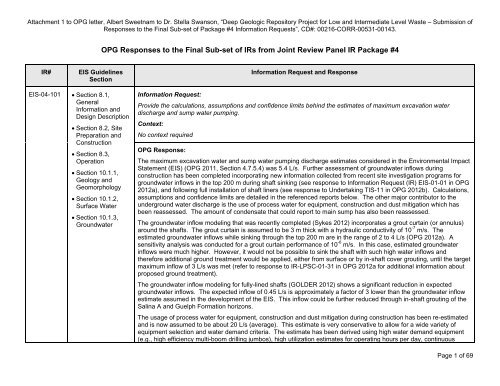Ontario Power Generation's Response to the Joint Review
Ontario Power Generation's Response to the Joint Review
Ontario Power Generation's Response to the Joint Review
Create successful ePaper yourself
Turn your PDF publications into a flip-book with our unique Google optimized e-Paper software.
Attachment 1 <strong>to</strong> OPG letter, Albert Sweetnam <strong>to</strong> Dr. Stella Swanson, “Deep Geologic Reposi<strong>to</strong>ry Project for Low and Intermediate Level Waste – Submission of<br />
<strong>Response</strong>s <strong>to</strong> <strong>the</strong> Final Sub-set of Package #4 Information Requests”, CD#: 00216-CORR-00531-00143.<br />
IR# EIS Guidelines<br />
Section<br />
EIS-04-101 � Section 8.1,<br />
General<br />
Information and<br />
Design Description<br />
� Section 8.2, Site<br />
Preparation and<br />
Construction<br />
� Section 8.3,<br />
Operation<br />
� Section 10.1.1,<br />
Geology and<br />
Geomorphology<br />
� Section 10.1.2,<br />
Surface Water<br />
� Section 10.1.3,<br />
Groundwater<br />
OPG <strong>Response</strong>s <strong>to</strong> <strong>the</strong> Final Sub-set of IRs from <strong>Joint</strong> <strong>Review</strong> Panel IR Package #4<br />
Information Request and <strong>Response</strong><br />
Information Request:<br />
Provide <strong>the</strong> calculations, assumptions and confidence limits behind <strong>the</strong> estimates of maximum excavation water<br />
discharge and sump water pumping.<br />
Context:<br />
No context required<br />
OPG <strong>Response</strong>:<br />
The maximum excavation water and sump water pumping discharge estimates considered in <strong>the</strong> Environmental Impact<br />
Statement (EIS) (OPG 2011, Section 4.7.5.4) was 5.4 L/s. Fur<strong>the</strong>r assessment of groundwater inflows during<br />
construction has been completed incorporating new information collected from recent site investigation programs for<br />
groundwater inflows in <strong>the</strong> <strong>to</strong>p 200 m during shaft sinking (see response <strong>to</strong> Information Request (IR) EIS-01-01 in OPG<br />
2012a), and following full installation of shaft liners (see response <strong>to</strong> Undertaking TIS-11 in OPG 2012b). Calculations,<br />
assumptions and confidence limits are detailed in <strong>the</strong> referenced reports below. The o<strong>the</strong>r major contribu<strong>to</strong>r <strong>to</strong> <strong>the</strong><br />
underground water discharge is <strong>the</strong> use of process water for equipment, construction and dust mitigation which has<br />
been reassessed. The amount of condensate that could report <strong>to</strong> main sump has also been reassessed.<br />
The groundwater inflow modeling that was recently completed (Sykes 2012) incorporates a grout curtain (or annulus)<br />
around <strong>the</strong> shafts. The grout curtain is assumed <strong>to</strong> be 3 m thick with a hydraulic conductivity of 10 -7 m/s. The<br />
estimated groundwater inflows while sinking through <strong>the</strong> <strong>to</strong>p 200 m are in <strong>the</strong> range of 2 <strong>to</strong> 4 L/s (OPG 2012a). A<br />
sensitivity analysis was conducted for a grout curtain performance of 10 -6 m/s. In this case, estimated groundwater<br />
inflows were much higher. However, it would not be possible <strong>to</strong> sink <strong>the</strong> shaft with such high water inflows and<br />
<strong>the</strong>refore additional ground treatment would be applied, ei<strong>the</strong>r from surface or by in-shaft cover grouting, until <strong>the</strong> target<br />
maximum inflow of 3 L/s was met (refer <strong>to</strong> response <strong>to</strong> IR-LPSC-01-31 in OPG 2012a for additional information about<br />
proposed ground treatment).<br />
The groundwater inflow modeling for fully-lined shafts (GOLDER 2012) shows a significant reduction in expected<br />
groundwater inflows. The expected inflow of 0.45 L/s is approximately a fac<strong>to</strong>r of 3 lower than <strong>the</strong> groundwater inflow<br />
estimate assumed in <strong>the</strong> development of <strong>the</strong> EIS. This inflow could be fur<strong>the</strong>r reduced through in-shaft grouting of <strong>the</strong><br />
Salina A and Guelph Formation horizons.<br />
The usage of process water for equipment, construction and dust mitigation during construction has been re-estimated<br />
and is now assumed <strong>to</strong> be about 20 L/s (average). This estimate is very conservative <strong>to</strong> allow for a wide variety of<br />
equipment selection and water demand criteria. The estimate has been derived using high water demand equipment<br />
(e.g., high efficiency multi-boom drilling jumbos), high utilization estimates for operating hours per day, continuous<br />
Page 1 of 69
















